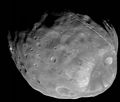Tugna:Phobos colour 2008.jpg

Tiddi n azaraskan agi : 636 × 600 iferdisen n tugna. Tibuda nniḍen : 255 × 240 iferdisen n tugna | 509 × 480 iferdisen n tugna | 815 × 768 iferdisen n tugna | 1 086 × 1 024 iferdisen n tugna | 2 172 × 2 048 iferdisen n tugna | 3 500 × 3 300 iferdisen n tugna.
Afaylu aneṣli (3 500 × 3 300 pixel, tiddi n ufaylu: 2,72 MB/MO, anaw n MIME: image/jpeg)
Amazray n ufaylu
Senned ɣef yiwen azmez d usrag iwakken ad ẓṛeḍ afaylu aken yella deg imir nni.
| Azemz/Ssaɛa | Aqmamaḍ | Iseggiwen | Amseqdac | Awennit | |
|---|---|---|---|---|---|
| Lux a | 2 Yebrir 2018 à 03:10 |  | 3 500 × 3 300 (2,72 MB/MO) | Kaldari | more margin on right side |
| 13 Wamber 2008 à 04:47 |  | 3 374 × 3 300 (2,7 MB/MO) | Fir0002 | == Summary == {{Information |Description=Colour image of Phobos, imaged by the Mars Reconnaisance Orbiter in 2008 |Source=NASA |Date=9 April 2008 |Location=http://www.nasa.gov/mission_pages/MRO/multimedia/pia10368.html |Author=NASA/J |
Aseqdec n ufaylu
Asebter agi teseqdac afaylu agi :
Aseqdec n ufaylu amatu
Iwikiyen-agi-nniḍen seqdacen afaylu-agi:
- Aseqdec ɣef af.wikipedia.org
- Aseqdec ɣef an.wikipedia.org
- Aseqdec ɣef ar.wikipedia.org
- المريخ
- فوبوس
- قمرا المريخ
- ويكيبيديا:صور مختارة/الفضاء والكون/نظرة إلى الأعلى
- قائمة أجرام المجموعة الشمسية مرتبة حسب الحجم
- بوابة:علم الفلك/صورة مختارة
- بوابة:المريخ/مقالة مختارة/أرشيف
- بوابة:المريخ/مقالة مختارة/2
- قائمة الأقمار الطبيعية
- خط زمني لاكتشاف كواكب المجموعة الشمسية وأقمارها
- ويكيبيديا:ترشيحات الصور المختارة/القمر فوبوس
- ويكيبيديا:صورة اليوم المختارة/أغسطس 2019
- قالب:صورة اليوم المختارة/2019-08-03
- بوابة:علم الفلك/صورة مختارة/73
- معسكر قاعدة المريخ
- ويكيبيديا:صورة اليوم المختارة/يناير 2022
- قالب:صورة اليوم المختارة/2022-01-04
- Aseqdec ɣef ary.wikipedia.org
- Aseqdec ɣef arz.wikipedia.org
- Aseqdec ɣef as.wikipedia.org
- Aseqdec ɣef azb.wikipedia.org
- Aseqdec ɣef az.wikipedia.org
- Aseqdec ɣef be-tarask.wikipedia.org
- Aseqdec ɣef be.wikipedia.org
- Aseqdec ɣef bg.wikipedia.org
- Aseqdec ɣef bh.wikipedia.org
- Aseqdec ɣef bn.wikipedia.org
- Aseqdec ɣef bn.wikibooks.org
- Aseqdec ɣef bs.wikipedia.org
Wali l’utilisation globale n ufaylu-agi.





